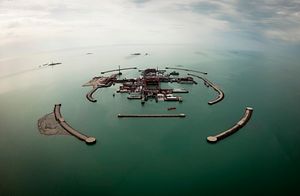In the past two decades since the collapse of the U.S.S.R. Kazakhstan has become a major oil producer. In 2013 Kazakhstan’s oil production surged to roughly 1.64 million barrels per day. A key element in Kazakhstan’s continued growth in oil exports will be the further development of its giant onshore Tengiz and Karachaganak fields and the coming online of its massive Caspian offshore Kashagan fields, along with the development of additional export capacity. But while Tengiz and Karachaganak are already up and running, Kashagan’s development has been far more troubled, and the difficulties in bringing it online persist.
Kazakhstan’s massive offshore Kashagan Caspian Sea field, discovered in 2000, is the world’s largest oil “super” field uncovered in the last 30 years, with potential reserves estimated to be as high as 70 billion barrels. It is the largest known oil field outside the Middle East and the fifth largest in the world in terms of reserves. In comparison, the Norwegian sector of the joint British-Norwegian North Sea oil fields contains approximately 30 billion barrels of recoverable crude. While North Sea oil was discovered in the early 1960s, its first well only began producing in 1971; costs and technological hurdles delayed full development of the fields until the 1980s, when rising oil prices, made the North Sea development profitable.
According to the U.S. government’s Energy Information Administration, “there are approximately 150 fields onstream in Kazakhstan, but the two largest projects, Tengiz and Karachaganak, accounted for more than 40% of the country’s year-to-date production in 2013.”
The total Kashagan Contract area covers more than 2,125 square miles of northern Caspian Sea waters and contains five separate fields — Kashagan, Kalamkas A, Kashagan Southwest, Aktote and Kairan.
The year after Kashagan was discovered, Kazakhstan signed a North Caspian Sea Production Sharing Agreement, under which Italy’s Eni under the joint-venture company name of AgipKCO (Agip Kazakhstan North Caspian Operating Co.) managed Kashagan. AgipKCO consists of Kazakhstan’s national hydrocarbon concern KazMunaiGas and Japan’s Inpex, both of which originally held an 8.33 percent share in the project, while ConocoPhillips held a 9.26 percent share. Four major foreign oil companies currently dominate the project – Eni, France’s Total, U.S. ExxonMobil and Anglo-Dutch Shell, which all held 18.52 percent stakes each.
In autumn 2007, however, the Kazakh government, citing environmental concerns and cost overruns, renegotiated the PSA agreement. When the dust settled in January 2008, KazMunaiGas increased its share in the Kashagan project from 8.33 percent to 16.81 percent as a result of its foreign consortium partners grudgingly surrendering 2 percent apiece of their stake while agreeing to pay up to $5 billion as compensation for lost profits due to cost overruns and significant delays in commercial production.
Bringing Kashagan online has proven to be a logistical nightmare. Many delays were due to cost overruns associated with the field’s adverse operating environment and complexity. The Kashagan reservoir is located more than 13,000 feet below the northern Caspian seabed and is under very high pressure (770 psi), with the hydrocarbons admixed with high levels of hydrogen sulfide. The northern Caspian’s shallow depth and extreme winter climatic conditions have precluded the use of conventional drilling and production technologies such as fixed or floating platforms, forcing the offshore facilities to be installed on artificial islands (drilling and hub islands) that house drilling and processing equipment.
Kashagan finally started producing oil on September 11, but a mere 13 days later production was suspended after a gas leak at the pipeline from Island D to the onshore Bolashak refinery was discovered. After the leak was repaired production resumed but on October 9 output was again halted again when another gas leak was discovered. Because of the gas leaks a number of analysts believe that commercial production could be many months away as a result,
Kashagan has cost an estimated $50 billion so far, five times early estimates.
While production was hoped to hit 370,000 bpd by 2015, rising to 1.5 million bpd soon after, it is obvious that such optimistic output figures will not be met anytime soon.
But, teething problems aside, it is too early to count Kashagan out. At least one investor is betting that Kashagan will fulfill its potential. On September 7, 2013 Chinese President Xi Jinping signed a 45 billion agreement with Kazakhstan’s state energy company KazMunaiGas for state-owned China National Petroleum Corp. to purchase an 8.33 per cent stake in Kashagan.
It is just going to be more expensive to bring the superfield online, hardly an unknown occurrence in the global energy sector.
This article was originally published at OilPrice.com. It is reprinted with permission.

































